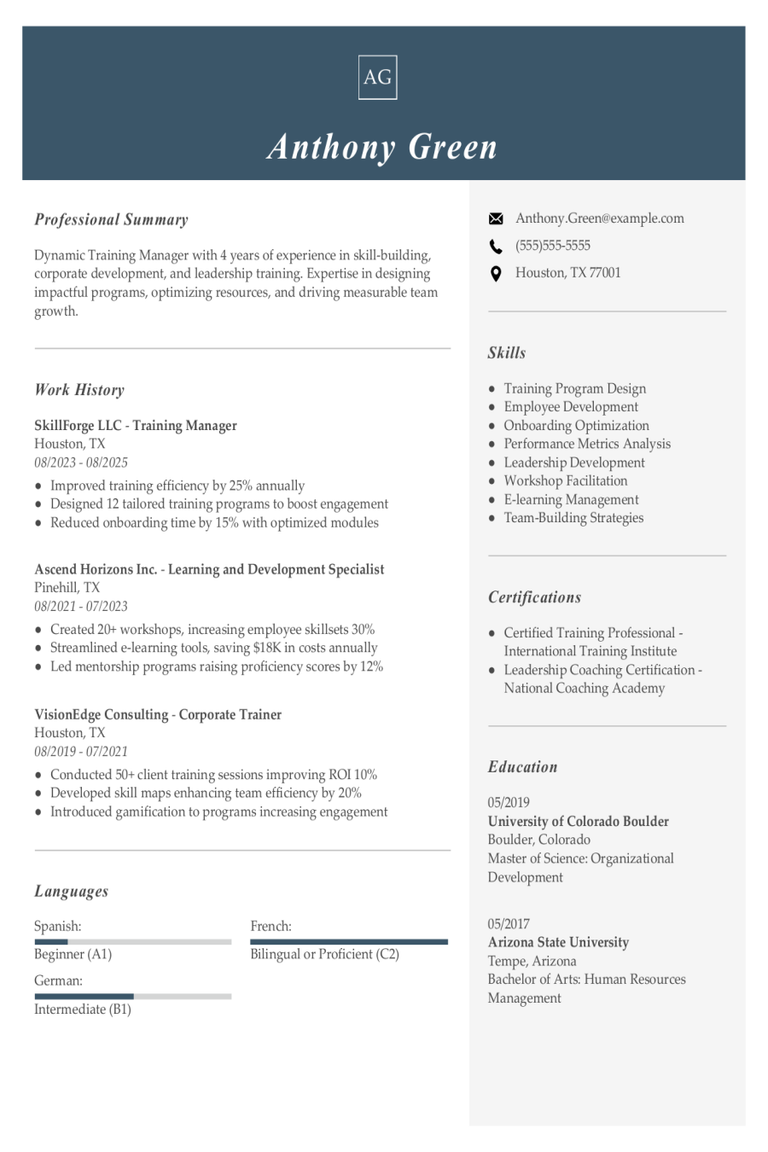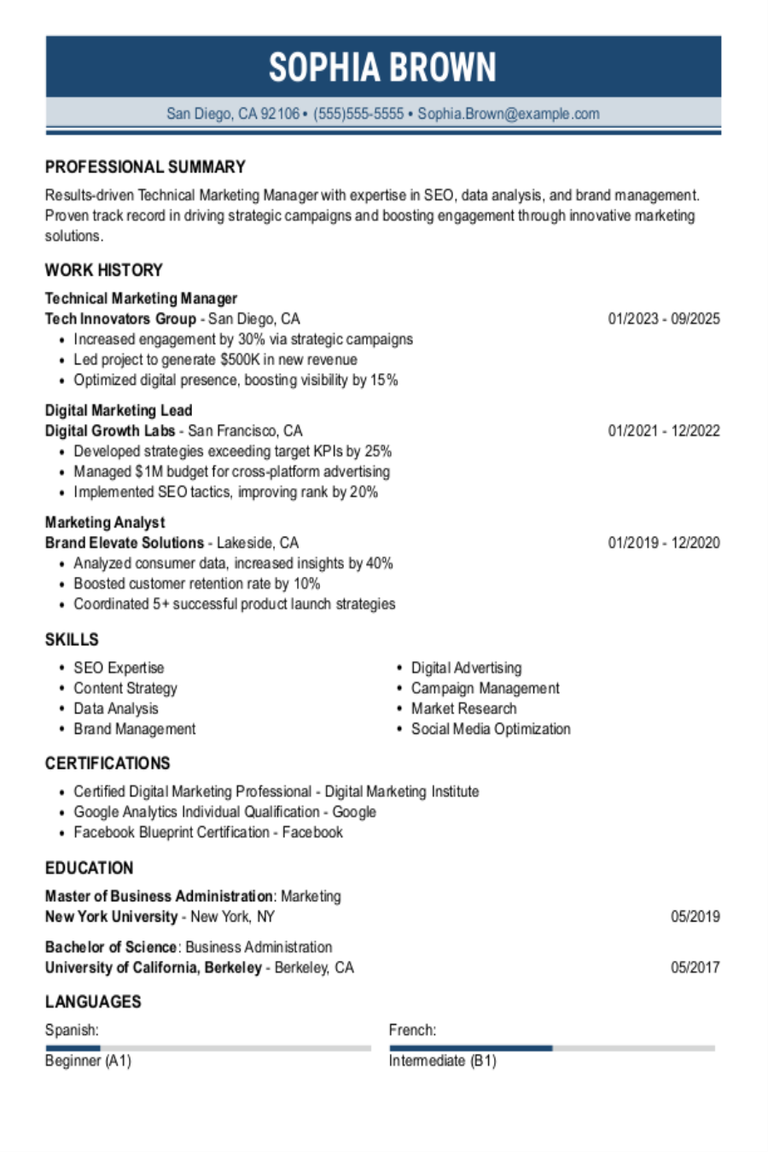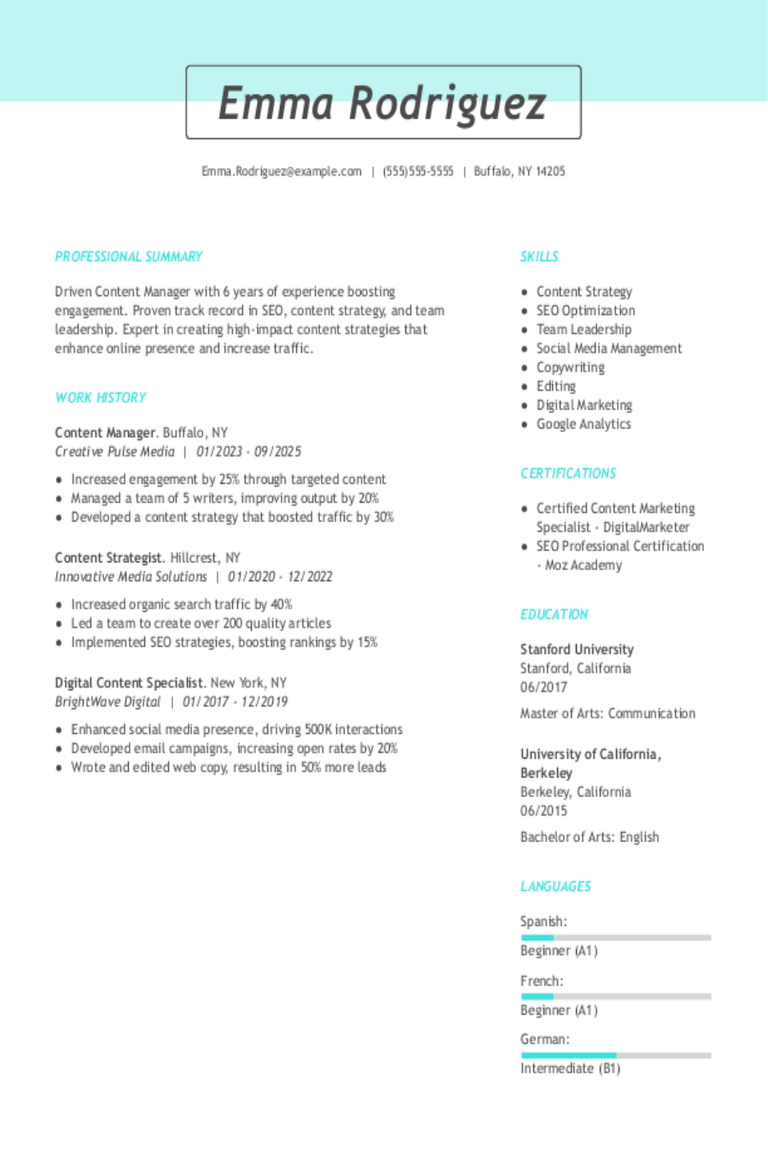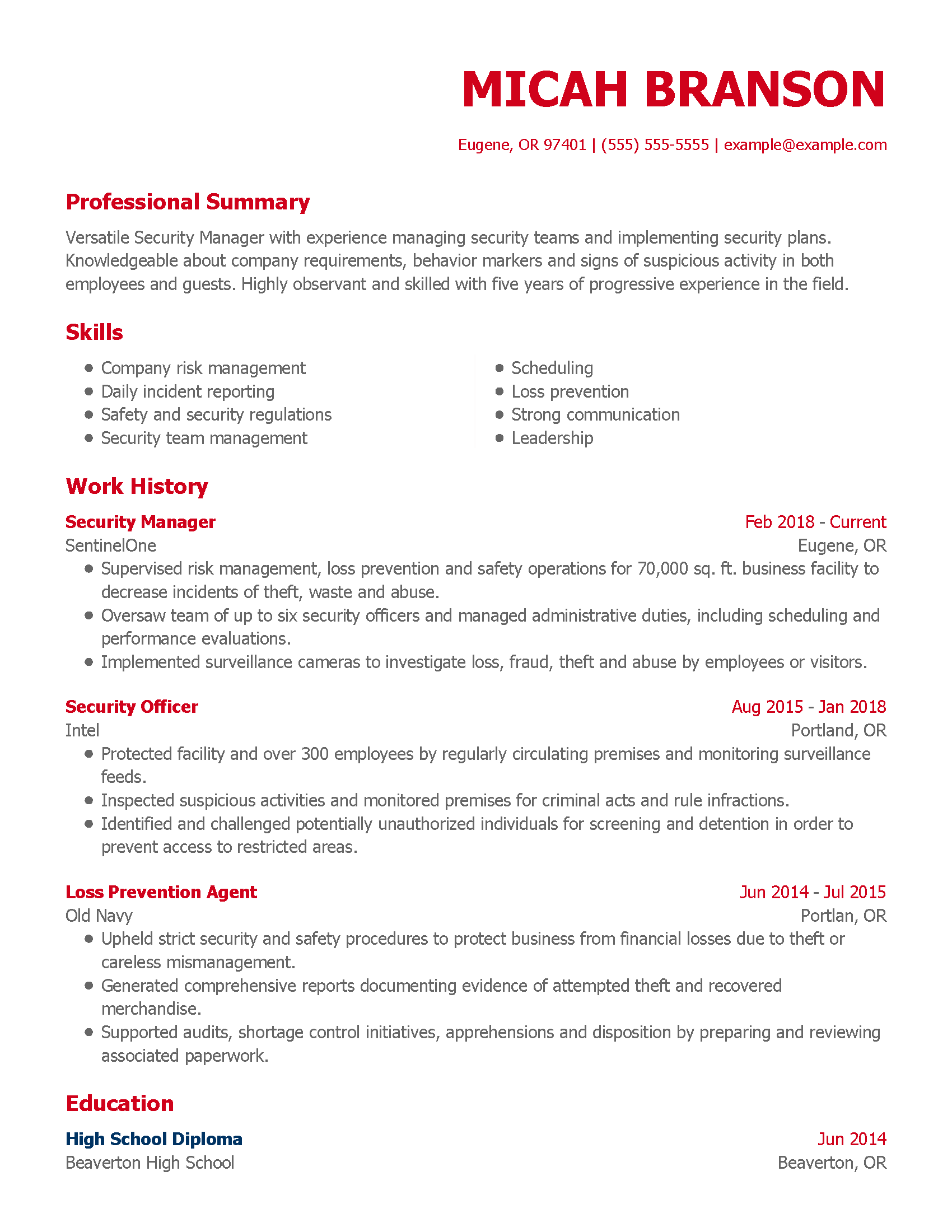Why this resume works
- Quantifies accomplishments: Measurable accomplishments, such as a 20% annual cost savings and a 30% efficiency increase, showcase the applicant’s impactful contributions.
- Uses action-oriented language: Action verbs such as “led,” “managed,” and “implemented” highlight the applicant’s proactive approach to driving projects forward.
- Illustrates problem-solving ability: Tackling challenges head-on by implementing cloud solutions to reduce downtime by 25% demonstrates the applicant’s problem-solving skills and initiative.
More Program Manager Resume Examples
Our program manager resume examples show how to highlight your leadership, organizational skills, and ability to drive projects to success. Use these resume samples to build a resume that showcases your expertise and project management experience.
Entry-Level Program Manager
Why this resume works
- Effective use of keywords: Strategically embedding role-specific keywords like “project management” and “strategic planning” optimizes the resume for applicant tracking systems (ATS).
- Puts skills at the forefront: Placing key abilities such as budget management and team leadership at the top aligns with a skills-based resume format, ideal for entry-level roles.
- Centers on academic background: Highlighting academic achievements like an MBA from UC Berkeley conveys a strong educational foundation, critical for early-career professionals.
Mid-Level Program Manager
Why this resume works
- Points to measurable outcomes: Quantifying achievements like a 25% reduction in project time and boosting productivity by 20% showcases the applicant’s focus on delivering impactful results.
- Demonstrates language abilities: Language skills in Spanish, French, and Mandarin improve cross-cultural communication, broadening opportunities for international collaboration.
- Includes a mix of soft and hard skills: Mixing technical expertise with interpersonal skills, such as cross-functional leadership, shows a balanced approach to project management.
Experienced Program Manager
Why this resume works
- Emphasizes leadership skills: The applicant’s role as a program manager at Innovate Solutions Inc. showcases leadership skills through managing international teams, optimizing budgets, and improving product delivery significantly.
- Lists relevant certifications: By listing certifications like Certified ScrumMaster and PMP, the applicant emphasizes their dedication to mastering project management methodologies and continuous learning.
- Sections are well-organized: Clear headers paired with concise bullet points make the resume easy to navigate, highlighting key achievements and skills in an organized manner.
Program Manager Resume Template (Text Version)
Li Davis
Lakeside, CA 92058
(555)555-5555
Li.Davis@example.com
Professional Summary
Program Manager with over 9 years managing complex projects. Expert in agile methodologies and cost reduction.
Work History
Program Manager
Tech Innovators Inc – Lakeside, CA
May 2022 – June 2025
- Led 5 projects saving 20% costs annually
- Managed 10 team members to increase efficiency 30%
- Implemented cloud solutions reducing downtime by 25%
Project Coordinator
FutureTech Solutions – Los Angeles, CA
April 2018 – April 2022
- Coordinated cross-functional teams of 15 personnel
- Enhanced productivity by 18% via workflow automation
- Oversaw budget planning saving 15% project costs
Business Analyst
InnoVenture Labs – Los Angeles, CA
January 2016 – March 2018
- Analyzed data improving process efficiency by 15%
- Identified cost-saving strategies, reducing spend 12%
- Developed use cases enhancing system usage 20%
Languages
- Spanish – Beginner (A1)
- French – Beginner (A1)
- German – Beginner (A1)
Skills
- Project Lifecycle Management
- Agile Methodologies
- Cross-Functional Leadership
- Cost Reduction Strategies
- Risk Management
- Data Analysis
- Communication
- Team Coordination
Certifications
- Certified ScrumMaster (CSM) – Scrum Alliance
- PMP Certification – Project Management Institute
Education
Master of Business Administration Project Management
Massachusetts Institute of Technology Cambridge, Massachusetts
June 2015
Bachelor of Science Business Administration
University of Illinois Champaign, Illinois
May 2013
Related Resume Guides
- Aviation
- Banking
- Billing And Collections
- Biology
- Boating
- Business Operations
- Casino
- Chemistry
- Child Care
- Civil Engineering
- Compliance
- Computer Hardware
- Computer Software
- Construction
- Copywriting
- Cosmetology
- Costco
- Culinary
- Customer Service
- Dance
- Data Systems Administration
- Deloitte
- Dentistry
- Driving
- Education
- Electrical
- Electrical Engineering
- Energy
- Engineering
- Entertainment
- Entrepreneur
- Entry Level
- Environmental
- Environmental Science
- Event Planning
- Executive
- Fashion
- Film
- Finance
- Fitness And Nutrition
- Food Service
- Freelancing
- General Laborer
- Goldman Sachs
- Government
- Graphic Design
- Healthcare Support
- Hospitality
- Human Resources
- HVAC
- Industrial Engineering
- Information Technology
- Insurance
- Interior Design
- Inventory Management
- Janitorial
- Landscaping
- Language Services
- Law
- Law Enforcement
- Library
- Logistics
- Maintenance
- Marketing
- McKinsey
- Mechanical Engineering
- Mechanics
- Media And Communication
- Medical
- Mental Health
- Meta
- Metal Work
- Military
- Mining
- Museum
- Music
- Netflix
- Non Profit
- Nursing
- Pharmaceutical
- Photography
- Physical Therapy
- Plumbing
- Politics
- Production
- Project Manager
- Psychology
- Purchasing
- Quality Control
- Real Estate
- Religion
- Retail
- Safety And Security
- Sales
- Sciences
- Shipping
- Social Services
- Special Education
- Sports
- Statistics
- Student
- Teaching
- Team Lead
- Tesla
- Training And Development
- Transportation
- Travel
- Veterinary
- Walgreens
- Walmart
- Web Development
Advice for Writing Your Program Manager Resume
Explore our tips on how to write a resume and tailor your experience to show you’re ready to take charge and deliver results in this dynamic role. Discover how to craft a standout program manager resume that highlights your leadership skills and knack for keeping projects on track.
Highlight your most relevant skills
A dedicated skills section on your resume helps employers quickly see what you can do and how you match their needs. It’s ideal to include a mix of technical skills, like project planning and budgeting, and soft skills, like communication and leadership.
When creating your resume, weave skills into your work experience, too. This makes your resume more powerful by showing how you’ve used these skills in real situations. For example, if you have led a team successfully, talk about it in your job history. This approach shows employers that you’re not just saying you have these skills—you’ve used them effectively before.
Balancing hard and soft skills is key for a program manager role. Employers want someone who can handle technical tasks but also work well with others. By clearly showing both types of skills on your resume, you’ll stand out as a well-rounded applicant ready to take on the challenges of managing programs successfully.
Select a resume format that highlights your skills in managing projects, teams, and deadlines for the most impact.
Showcase your accomplishments
When showcasing your accomplishments as a program manager, arrange your work experience in reverse chronological order. Start with your most recent job and go backward. For each role, include the job title, employer name, location, and employment dates. This format helps hiring managers quickly see your career progression and recent achievements.
Instead of just listing what you did at each job, focus on quantifying your accomplishments. Numbers tell a story that duties alone can’t. Use percentages or other measurable results like cost reductions or time savings. Turn duties into achievements by showing how you improved processes or met goals using action words that highlight what you accomplished.
Quantified accomplishments make it easier for hiring managers to see your impact as a program manager. They want to know what skills you bring to the table and how you’ve made a difference in past roles. By using numbers and strong verbs, you paint a clear picture of your capabilities and successes, making your resume stand out from the rest.
5 program manager work history bullet points
- Led cross-functional teams to deliver 10+ projects within deadlines, improving project completion rate by 25%.
- Streamlined program processes, reducing operational costs by 15% through effective resource allocation.
- Implemented agile methodologies, increasing team productivity by 30% and achieving higher client satisfaction scores.
- Managed stakeholder communications, securing $2M in additional funding for project expansion.
- Developed comprehensive risk management strategies, minimizing project risks and ensuring the timely delivery of critical milestones.
Select a clean and straightforward resume template with clear section headings, skipping flashy designs or fancy fonts that might distract from your key information.
Write a strong professional summary
A professional summary is the opening section of a resume that introduces your qualifications to hiring managers. It serves as a snapshot of your skills, experience, and career achievements.
You can decide whether to use a summary or a resume objective based on your professional background and goals.
A professional summary highlights what you’ve accomplished in your career. Typically three to four sentences long, it showcases your expertise, relevant skills, and measurable results. This format is ideal for experienced applicants like program managers who want to present their value up front by outlining how they’ve successfully led teams, delivered projects on time, or improved processes.
Resume objectives focus more on career goals rather than past achievements. They are best for entry-level applicants, career changers, or those with employment gaps. While summaries show “what I’ve done,” objectives emphasize “what I aim to contribute.” For example, a program manager shifting industries might use an objective to express their transferable leadership abilities.
Next, we’ll explore examples of both summaries and objectives tailored to different roles and levels of experience. You can browse our library of resume examples for additional inspiration.
Program manager resume summary examples
Entry-level
Recent graduate with a Bachelor of Business Administration, focused on project management and strategic planning. Completed an internship in program coordination, gaining exposure to scheduling, resource allocation, and stakeholder communication. Certified Associate in Project Management (CAPM) holder with strong analytical skills and a keen interest in driving successful project outcomes.
Mid-career
Program manager with over seven years of experience in the technology sector, leading cross-functional teams to deliver complex projects on time and within budget. Demonstrated success in process optimization, risk management, and vendor relationships. Known for implementing agile methodologies that improve team productivity and product quality while improving client satisfaction.
Experienced
Seasoned program manager with more than 15 years of expertise in the healthcare industry, specializing in large-scale program implementations and transformative initiatives. Proven track record of steering multimillion-dollar projects from inception through completion, ensuring alignment with strategic goals. Recognized for leadership excellence, fostering collaborative environments that drive innovation and sustainable growth.
Program manager resume objective examples
Entry-level
Aspiring program manager with a strong background in project coordination and team collaboration, seeking to leverage organizational skills and strategic planning abilities in a dynamic corporate environment. Committed to driving successful project outcomes and continuous improvement initiatives.
Career changer
Detail-oriented professional transitioning from operations management to program management, bringing expertise in process optimization and cross-functional team leadership. Enthusiastic about contributing to innovative projects while improving organizational effectiveness and efficiency.
Recent graduate
Ambitious recent business administration graduate with a focus on project management principles, eager to apply analytical skills and creativity as an entry-level program manager. Dedicated to fostering effective communication and delivering projects that align with company goals.
Easily create a standout resume with our Resume Builder. Choose a template, fill in your details, and let it do the rest for you!
Match your resume to the job description
Tailoring your resume to job descriptions is key because it helps you stand out and pass through applicant tracking systems (ATS). Employers use ATS to scan resumes for specific keywords and phrases. If your resume matches these terms, you’re more likely to get noticed. This means understanding the job description and aligning your resume with it can be an important step.
An ATS-friendly resume includes keywords that fit both the job description and your skills. These keywords are what hiring managers look for when they first review applications. By using them correctly, you make it easier for the system to recognize your qualifications, increasing your chances of advancing in the hiring process.
To find the right keywords, carefully read the job posting. Look for repeated skills, qualifications, or duties like “project management,” “team leadership,” or “budget oversight.” Using exact phrases from the posting shows that you understand what’s needed for the role and have relevant experience.
Incorporate these terms naturally into your resume by rewriting past job experiences. For example, change “Managed team projects” to “Led team projects on time and within budget.” This not only highlights required skills but also demonstrates how you’ve applied them successfully.
Customizing your resume improves ATS compatibility by ensuring that both systems and hiring managers quickly recognize you as a strong fit for the program manager role. Tailoring your content this way maximizes your chances of landing an interview.
Make your resume stand out fast! Our ATS Resume Checker analyzes your resume and offers quick tips to improve your chances with hiring managers.
FAQ
Do I need to include a cover letter with my program manager resume?
Yes, including a program manager cover letter with your application can improve your application by highlighting your unique strengths and experiences. A cover letter gives you the chance to explain why you’re passionate about the specific projects or initiatives the company is working on and how your skills align perfectly.
If the organization has certain methodologies or project types (like Agile frameworks or cross-functional team management), you can discuss your expertise in these areas in more detail.
You might consider using tools like our Cover Letter Generator to craft a tailored cover letter based on your resume details, ensuring it reflects industry best practices. Additionally, reviewing cover letter examples from our library can provide inspiration and guidance on effectively showcasing your qualifications.
How long should a program manager’s resume be?
For a program manager, a one-page resume often works well if you have under 10 years of experience. It allows you to focus on key accomplishments like managing cross-functional teams, delivering projects on time and within budget, and streamlining processes.
If you have extensive experience or significant achievements—such as overseeing complex programs or driving major organizational change—a two-page resume is acceptable. Just ensure every detail supports your ability to lead programs effectively and aligns with the role you’re targeting.
Explore our guide on how long a resume should be for examples and tips tailored to different career stages.
How do you write a program manager resume with no experience?
If you’re aiming for a program manager role but lack direct experience, tailor your resume with no experience to highlight transferable skills, relevant education, and projects showcasing your capability in managing programs or leading teams. Here are a few tips to help you get started:
- Highlight project-based experience: If you’ve worked on school, volunteer, or personal projects where you organized tasks, managed timelines, or coordinated with others, describe those experiences in detail. Focus on outcomes and measurable results.
- Emphasize transferable skills: Skills like communication, problem-solving, organization, and leadership are key for program managers. Use examples from previous jobs (even unrelated ones) to show how you’ve applied these abilities effectively.
- Include coursework or certifications: If you’ve studied topics like project management methodologies (e.g., Agile or Scrum), risk assessment, or operations management—include them! Certifications like PMP or CAPM can also strengthen your resume.
- Showcase tools and software knowledge: Familiarity with tools like Microsoft Project, JIRA, Trello, or Gantt charts is valuable for program managers. Mention any experience using them in work settings or self-initiated projects.
Tailor your resume to the job description by aligning your skills and achievements with the requirements of the role.
Rate this article
Program Manager
Additional Resources

Program Manager Cover Letter Example + Tips
Here are some helpful writing guidelines to help you craft your cover letter based on this free program manager cover letter sample. First of all, you want to avoid clichés

25 Interview Questions for Managers (With Answers & Tips)
Success in a management interview starts long before the conversation begins. Taking the time to prepare thoughtful responses to common interview questions for managers helps you clearly communicate leadership experience

Training Manager Resume Examples & Templates for 2025
Discover how training managers showcase their skills in leading workshops and improving employee performance on their resumes. Our examples and tips will help you craft a resume that stands out

Technical Marketing Manager Resume Examples & Templates for 2025
Discover how to craft a technical marketing manager resume that shines. Learn to highlight your tech-savvy skills, marketing strategies, and project successes effectively.Build my resumeImport existing resumeCustomize this templateWhy this

Content Manager Resume Examples & Templates for 2025
Browse content manager resume examples to see how to highlight your experience organizing, creating, and sharing engaging materials across platforms. These examples and tips help you showcase creativity, leadership, and

Security Manager Resume Examples & Templates for 2025
Explore security manager resume examples that showcase leadership, emergency response, and risk management. Get tips to highlight your skills and experience in keeping people and property safe.Build my resumeImport existing
